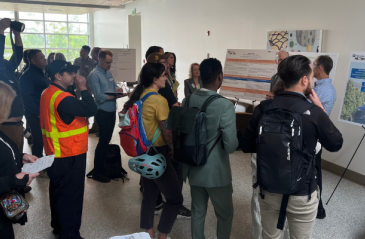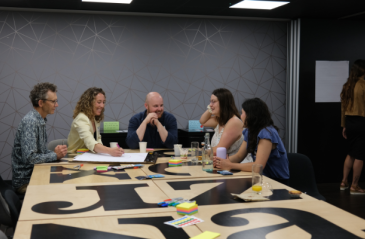
The information barriers holding back climate action and how to break them

The Collaboration Studio aims for cross-cutting performance improvements
Share articleThe Collaboration Studio provides collaboration design and facilitation services
Share articleThe Studio brings divergent voices together and leave united as one
Share articleWe put our vision for government into practice through learning partner projects that align with our values and help reimagine government so that it works for everyone.
Few landscapes are as complex as the US Federal Government. The number of its organisations, its scale of operations and sheer size has no global equal. On any given day, its workforce - which numbers over 2 million - has to juggle myriad initiatives and policies, projects and services, which stretch far beyond the beltway from sea to shining sea.
Inevitably, the scope of the government's operations, as well as its mix of agencies large and small, has given rise to some siloes and issues which can inhibit performance. This is where the Performance Improvement Council's Collaboration Studio comes in. Under the leadership of its director, Stephanie Brown, it seeks to help teams of cross-agency federal employees achieve breakthroughs in their initiatives through a variety of cutting-edge facilitation techniques.
"We have this unique opportunity to be an advisor, a friend and a collaborator with many different types of federal organisations but, most importantly, a convener across these organisations," explains Brown. "And because of our unique position in the federal government, we can provide an informed yet neutral and unbiased voice to convene groups and leverage multiple perspectives to increase the collective understanding. We have a strong belief that challenges are best solved collectively. And this is why we bring people together, to have conversations that identify powerful insights, insights that can drive action.”
The Performance Improvement Council - which until recently was headed up by Kate Josephs - was created in 2007 through an Executive Order and established in 2010 in legislation to advance and expand the practice of performance improvement in the federal government. Its principal goals are to "foster widespread and effective use of performance management practices" and "spark cross-cutting performance improvements". The Collaboration Studio forms part of its efforts to achieve the latter.
"The role of the Collaboration Studio is, in essence, to provide collaboration design and facilitation services through the PIC," explains Brown. "We sit in a unique spot in the federal government, in between the agencies, the Performance Improvement Officers' Council and the Office of Management and Budget, and this supports our approach. When groups convene, we want to ensure that we create an environment and process that can surface thorny issues in a non-threatening way. I specialise in graphic facilitation, which at its core, is: 'you talk, I draw'. As teams and groups are having conversations, I listen, draw out the key issues and synthesise ideas. I make the implicit explicit through images, text and graphics. And it is a lot easier for folks to be in conflict with something drawn on the wall than each other. At the end we have a collective memory of the conversation as it has taken place which can be used as a platform for conversations moving forward."
Brown and her colleagues also use other facilitation methods and techniques, codesigning and co-delivering with these teams. "We're designing an experience of collaboration that can bring out some of the common needs and understandings, and our goal is to have a common agreement of how the group is going to move forward," she adds.
A particular focus of the Collaboration Studio has been its work to support the work of the Cross-Agency Priority Goals, which are made up of seven mission-oriented and eight management-focused presidential priority areas where implementation requires active collaboration between multiple agencies. Brown explains that the organisational structure of the government and its budget processes are not set up to reflect the eclectic demands of delivering on these 15 priorities.
"We're trying to figure out how we're all going to contribute to these goals," she says. "Although it is a challenge for us to figure out how to make this happen on these horizontal issues, I truly believe that a key factor is cultivating a culture of collaboration and performance. In order to change the culture, we have to change the way we work together. And to change how we work together, we need to change how we talk together. If we do this, then I believe we can overcome these other structural challenges that can sometimes impede the actions we want to take."
Brown is in no doubt that the changes already engendered by the Studio are here to stay. This is because of the extra effort she and her colleagues put in to ensure that the teams exit their engagements in agreement about how to move forward. "We bring in different voices and we focus in on listening to what is being shared to expand perspectives - which isn't always the same as what people entered the room with," she says.
"To do this, we seek to ask the right questions in order to bring out what everyone is really thinking. On the cross-agency priority goals we are sometimes brought in to help understand the definition of something that is central to the goal, or it can be about gaining a common understanding of how all the team contributes. How we design these collaborations to build understanding, shape choices and make decisions is central to the value we provide.”
The PIC team which supports the Performance Improvement Officers' Council was established under the GPRA Modernization Act of 2010 and, with another presidential election rapidly coming over the horizon, it seems pertinent to ask whether or not a new president will preserve its position in the federal landscape. Brown, while admitting that there is always an opportunity for a new administration to have a new focus or a different take on how to manage performance, points out that the PIC itself is established in legislation that assures its existence into the next presidency and beyond.
"I believe that the work we have done in the Collaboration Studio as a part of the PIC team has demonstrated real value," she says. "We foresee being an even more central part of how the cross-agency priority goals are implemented in the future, but we're also committed to continuing our work with agencies in terms of their particular priorities as well.
"One of the projects I'm particularly excited by is our work to support improving customer service, a priority of our administration. One of the large agencies asked us to provide training for journey mapping and innovation sprints, two methods we often employ in our designs. We asked to make the training more powerful with the addition of coaching. By coaching these team members through their own real-world projects, not only do they practice what they learned, they are also identifying opportunities to improve service and involving other colleagues in the process. We are helping to embed a customer-centric perspective in the organisation culture as they move forward. And we have more agencies interested in similar coaching programmes to help scale the initiative. To change the culture we have to change the way we work, and this project is the embodiment of that belief.”
Such examples, she believes, showcase the power of convening and collaboration: bringing divergent voices together around a table and leaving united as one. "One of the greatest opportunities we have to solve the complex challenges government faces is to bring the right people into a room and create the conditions for a really meaningful conversation," she concludes. "It's all about the conversation. The insights and then the impact all flow from meaningful conversation."











